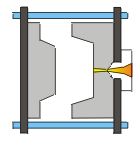How Are Aluminum Heat Sinks Die Castings Made? Heat sinks are used to reduce or remove heat from electrical appliances. Essentially, these heat sinks are used to prevent appliances from overheating and breaking down. Currently, more and more heat sinks …
Continue reading
Tag Archives: aluminum parts
The Die Casting Part Production Process Explained.
What is the Die Casting Process? The Die Casting Part Production Process Explained.
Kinetic Die Casting Company uses a manufacturing process called “Die Casting” to make aluminum die casting parts and zinc die casting parts. But, what is the die casting part production process? Here is a GIF image I have on our home page to demonstrate:

demonstration of the die casting process
“Aluminum die casting is an aluminum metal parts production process where molten aluminum metal alloy is injected into a steel die, under extreme pressure, to manufacture aluminum parts” (Substitute the word “zinc” for “aluminum” in zinc die casting part production process)
Another GIF example example is on this web page:
(click) What is Die Casting?
Another demonstration of the die casting process

Cold Chamber Die Casting Process
The image pictured above depicts a Cold Chamber Die Casting Machine as it makes parts. The term “Cold Chamber Die Casting” refers to a separate metal melting furnace. The High Pressure Die Casting, cold chamber die casting process follows this sequence:
- Look at the die casting machine image above
- The die casting machine opens the die casting mold.
- The prior part is removed and the die cast mold is sprayed for the next part
- The aluminum is poured using a ladle into a shot cylinder
- The shot piston injects the metal into the die casting mold.
- The machine opens and the process starts again.
Contact Kinetic Die Casting Company for more information about the high pressure die casting process and about how to get great die casting parts at a great price and delivered quickly, no matter what quantity you need.
Kinetic Die Casting manufactures aluminum military parts, aluminum hardware, and aluminum die castings. Visit our website for a quote: Kinetic Die Casting Company
Die Casting
Die Casting. Die casting is a very ordinary method of producing metal parts. In the method of high pressure die casting, melted metal alloy such as aluminum alloy is inserted into a mold called a die like zinc die cast tooling. The metal is left in the steel mold until it hardens and then it is detached.
There are two types of machines that are utilized in die casting. First is the hot chamber machine, also called piston or gooseneck machine, and the second is the cold chamber machine. The hot chamber machine has the metal injection device, or gooseneck, submerged in the melted metal within the holding furnace. This machine works by having the gas or oil-powered piston retracted and allowing the melted metal to fill the gooseneck. The melted metal is then forced out of the gooseneck by the piston and the metal goes into the die. Not all metal alloys can be utilized in the hot chamber machine. Due to this, cold chamber die castings must be made. Aluminum and metals with high melting points like copper, magnesium, and zinc alloys require the cold chamber machine. The cold chamber machine does not have the piston absorbed in the melted metal. Before utilizing the cold chamber machine, the metal must be liquefied first in a disconnected furnace. Then the liquefied metal is brought to the cold chamber machine and injected into a cylinder and a hydraulic piston forces the metal into the die. Cold chamber die castings take longer to manufacture because the metal has to be melted in an separate furnace.
It doesn’t matter whether parts are hot chamber or cold chamber die castings. Both these products are completed using the magnificent manufacturing method known as die casting. Therefore, you will have products such as die cast speaker, aluminum die cast boxes, and aluminum heatsinks.
Kinetic Die Casting manufactures aluminum and zinc die casting parts. Samples of KDC’s work include die cast speaker parts, aluminum tile plates, and other die cast metal parts. If you would like to have a quote please visit our website: Kinetic Die Casting Company
The Pros and Cons of Cold Chamber Die Castings
The Pros and Cons of Cold Chamber Die Castings. Cold chamber die castings utilize Cold Chamber machines to make easy die castings. Cold chamber die casting is one of the two die casting methods. The other one is Hot Chamber castings which sometimes utilizes Hot Chamber zinc castings.
Cold chamber die castings engage the utilize of a metal cylinder where the melted metal alloy is poured. The melted metal then will be pushed by an injection pump into the die cast thus manufactured metallic parts.
Cold chamber die castings allow for the manufacturing of aluminum, zinc, and certain alloys of magnesium. In fact, these outstanding materials for fabricating parts can only use cold chamber die casting methods.
The huge benefit of cold chamber die castings is that the process can make denser metal castings. Denser metal is fashioned owing to the higher pressure utilized during the injection development. Density can also be qualified to higher speed procedure of cold chamber injection. Another benefit of cold chamber die cast manufacturing is its low maintenance cost. Through cold chamber castings, manufacturers can produce more parts with lower overhead costs. This drives down the market prices of aluminum parts.
Cold chamber die castings also have several disadvantages. First, cold chamber manufacturing has slower production cycles. The melted metal in the cold chamber can cool down even before injection. Finally, the melted metal in the cold chamber is barer to oxidation and other contaminants chiefly if the production floor does not have strict quality control.
Cold chamber die castings can offer many advantages for die cast parts manufacturers. The benefits and advantages one can get from the cold chamber method can outweigh its disadvantages. Metals used in cold and hot chamber methods include 380 Aluminum, zinc, and other aluminum alloys.
Kinetic Die Casting is a die casting company specializing in aluminum and zinc parts. If you would like to request a quote, please visit our website:Kinetic Die Casting Company
Cold Chamber Die Castings – A Look at the Procedure
Cold Chamber Die Castings – A Look at the Procedure. Die casting is a process that is in one way or another like to that of permanent mold casting. The only point of distinction lies in the fact that the metal is essentially injected into the mold by utilizing a high pressure. This allows the production of a more precise dimension and better surface finish, so to speak. In many circumstances, the use of post machining can already be eradicated since the output is utterly awesome. Light machining methods may be necessary in some occasions just for the function of sizing up the dimensions. Now the cold chamber die castings are also among the many procedures utilized these days.
With the popularity of cold chamber die castings comes the value of zinc or aluminum alloy castings. It is owing to the reality that among other alloys, the zinc die casting alloys and aluminum have high melting points. The cold chamber is also known as the cylindrical sleeve and it is where the melted metal is dispensed. The medium utilized is either a manual hand ladle or an automatic ladle. There is also a hydraulically operated plunger which shuts the cold chamber port and then forces the metal straight towards the locked die utilizing high pressures.
In terms of the method of cold chamber die castings, the melted metal that is inputted into the cold chamber or cylindrical sleeves experiences a compact time exposure to the plunger or its walls. Along with aluminum parts, the brass parts die casting are also utilized along with iron because of their properties which are very much conducive for use with higher temperatures.
.
Kinetic Die Casting manufactures zinc and aluminium die casting. If you would like a quote, please visit our website:Die Casting quote
Die Casting Parts Machining Requirements and Advantages.
Machining Die Casting Parts, Die Casting Parts Machining Requirements and Advantages.
Kinetic Die Casting Company produces many types of die casting parts that are machined as a secondary process, but we also produce many parts that do not need to be machined because we die cast the features into the parts. Here are a few examples of parts that are typically produced as a die casting parts because it saves money to make them as die castings.
HEAT SINKS –
Heat sinks in the past were always extruded in aluminum because aluminum is one of the best materials for heat conductance (more info) but the extrusions creates a lot of waste material and the additional cost to chop the heat sinks to length and machine mounting holes.
These reasons make die casting aluminum a far superior manufacturing process. Aluminum Die Castings are produced to the size and shape necessary with no wasted material. Die casting heat sink parts do not require additional machining to “chop” to size. Mounting holes are produced during the manufacturing process at no additional cost.
SAND CASTINGS
Sand castings cannot maintain the tolerance that die castings typically hold. Sand castings need a greater amount of variance from feature to feature. Many times a sand casting part will require machining in an interior section of a part between features because the tolerance is greater than .002″ (about half the thickness of paper)
See our website:
• Die Casting Heat Sinks
• Sand Casting Information
Contact:
Kinetic Die Casting Company 818-982-9200 for more information or to get a price of a die casting part to replace a current heat sink or sand casting part.
Kinetic Die Casting manufactures zinc and aluminum die casting. If you would like a quote, please visit our website:Die Casting quote

